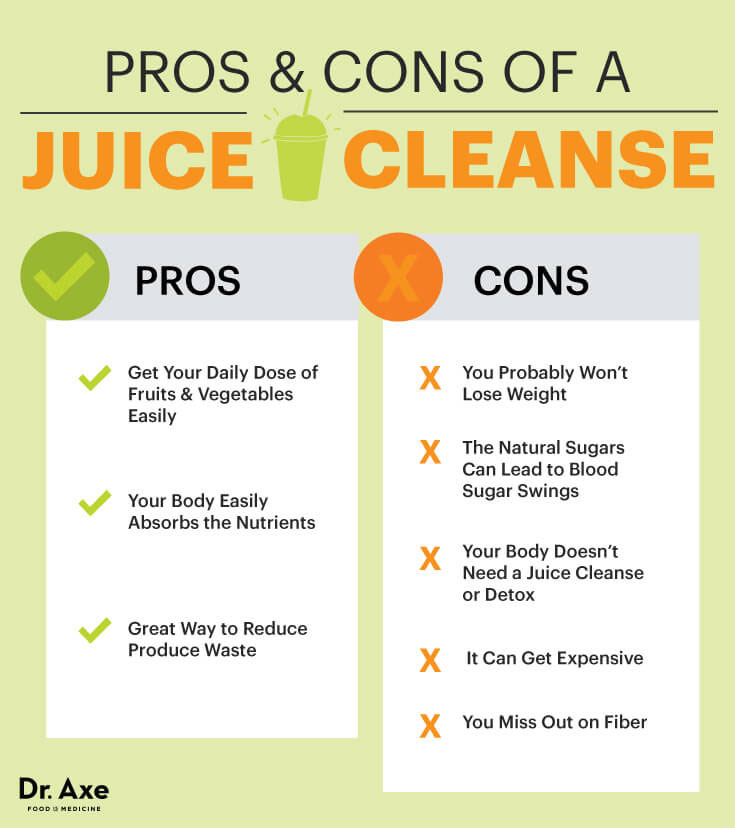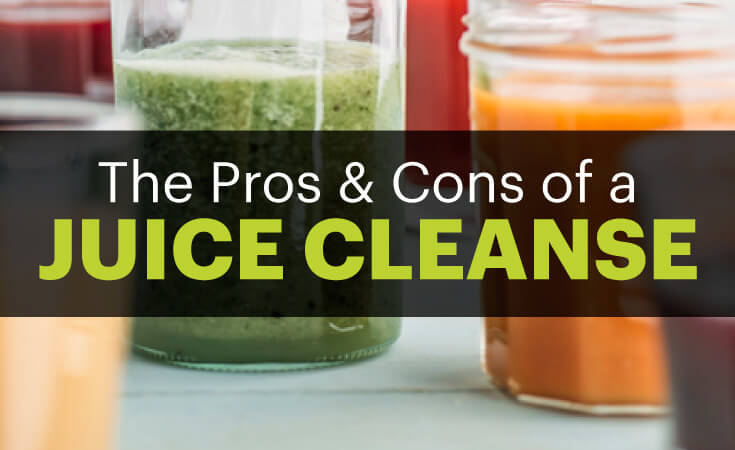The Pros and Cons of a Juicing Diet
From boutique juice shops to Instagram celebrities touting the benefits of juice cleanses, it seems we’ve discovered the new health craze – juicing.
While we’re all familiar with store-bought juices and juice-like substances – remember Sunny Delight? – making juices at home hasn’t always been as popular. These days, the hippie-inspired trend is gaining steam, as aficionados claim it helps shed pounds, prevent and heal disease and generally work as a miracle drink. But is juicing really as good for you as fans claim?
The Pros and Cons of a Juice Cleanse
If you’re interested in juicing, you’ll be happy to know that a juice cleanse does have quite a few benefits.
Pros
Enjoy your daily dose of fruits and veggies easily – and try new ones!
How many of us actually eat the seven servings of fruit, and especially vegetables, daily that are recommended to reduce the risk of premature death? While it can be difficult to figure out how to sneak in a few extra veggies with each meal or snack, juicing makes it much easier. Practically any fruit or vegetable can be juiced, allowing you to get in a heap of nutrients and vitamins you probably would otherwise miss out on.
Juicing also allows you to get adventurous with what produce you consume. Most of us purchase the same few fruits and veggies we’re used to eating to prepare at home. But juicing gives you the freedom to try new varieties, without having to hunt down recipes or worry whether the rest of the family will enjoy them. Just slip it into the juicer, and it’s ready for drinking.
Parents, juices are an especially good option if you have children who are picky eaters. They’ll enjoy drinking the juice, and you’ll love knowing that they’re sipping on nutritious ingredients.
Your body can easily absorb the nutrients
Drinking a juice is like taking a shot of instant nutrition goodness. Because all the insoluble fiber – that’s the fiber your body has to work a little harder to process – has been removed through the juicing process, digestion becomes a lot easier on the body.
Drinking a juice enables the body to better absorb the vitamins, minerals and enzymes the juice has to offer. Juicing is like taking a healthy multivitamin that actually tastes good.
It’s a great way to reduce produce waste
A shriveled carrot or sad-looking cucumber might not make for a good-looking addition to dinner, but either is excellent in juice cleanse recipes – and a good way to stop tossing out produce that’s a bit past its prime. Because 30 to 40 percent of food in America goes to waste, juicing is a savvy way to eliminate waste in your household and easy on the wallet, too.
Cons
Unfortunately, there are several disadvantages to juicing which need to be taken into account.
You probably won’t lose weight
If you’re planning on going on a juice-only diet, take note that you might find yourself feeling hungry significantly more often. It’s not just your imagination; it’s been proven that eating solid foods helps you reach satiety and feel fuller than drinking meals.
This is important when juicing, because one juice might have a caloric count that’s similar to a full meal, but it won’t keep you as full as chowing down whole foods might. That means if you’re regularly drinking juices, you might find yourself eating more food, and drinking more calories, to feel satisfied.
Juices also generally have no protein. If you’re trying to build lean muscle, a juicing diet will work against your efforts because if your body can’t get protein from what you eat, it’ll turn to where it can find it – your hard-earned muscles. And once you start losing muscle mass, your metabolic rate – the calories you burn even when you’re not working out – also drops. So once you begin eating solid foods again, you can expect the weight to return too.
Too much sugar can lead to blood sugar swings
Even when they’re homemade, juices contain quite a bit of natural sugar and much more than if you ate the food whole rather than juicing it. Think about it: when you eat an apple as a snack, you consume about 10 grams of sugar. But making apple juice requires significantly more than just one piece of fruit.
Multiply that 10 grams with however many apples it takes to fill a glass, and you’re looking at a potential sugar spike. For people with diabetes, blood sugar swings are best avoided because of their limited insulin production. And even for those people without diabetes, drastic changes in blood sugar can lead to a loss of energy once the sugar high has gone down.
Additionally fructose, the type of sugar found in most fruits, is removed from the bloodstream by the liver. If you’re on an all-juice diet or juice cleanse, the liver can become overwhelmed and convert the sugar to liver fat instead, making you more susceptible to insulin resistance – which leads to diabetes or heart disease. Thus, if you’re diabetic, you don’t want to add a juice cleanse to your diabetic diet plan.
Your body doesn’t need a juice cleanse or detox
This is a biggie. I’m an advocate for the benefits of adding detox drinks to your diet or spending a week on the Daniel Fast, focusing on whole, healthy ingredients and eliminating processed foods and alcohol from your diet to reduce toxins in the body. But generally speaking, if you eat healthily a majority of the time, your body naturally detoxes every day.
Switching to a juice-only cleanse can wind up doing more harm than good. If you’re feeling sluggish, low in energy or irritable, what good is a juice detox?
And that’s assuming you make all your own drinks during a juice cleanse or detox. There’s big money to be made in the juice detox business, with companies selling kits or retreats for hundreds of dollars. But truth be told, your body doesn’t need this type of detox for any extended period of time, as the best way to detox is through healthy eating, exercise and spending time outside in the sun and earthing.
It can get expensive
Speaking of those hundreds of dollars, juicing doesn’t come cheap. I’m an advocate for investing in your health because, after all, the food we eat is medicine. But you often need double to triple the amount of ingredients to make one juice than if you ate the food whole. If you buy fresh, organic produce, those numbers start to add up quickly, particularly if the entire family is enjoying juices.
Buying the juices premade can also get pricey. A bottle of raw-pressed juice from popular brands can set you back $8 a bottle. If you enjoy sipping on a juice a day, that’s over $200 a month for just one person. And a great deal of that hefty sticker price comes from claims that haven’t been proven true, such as cold-pressed juice is better for you.
Juicing also requires equipment that most families don’t have on hand. A proper juicer can set you back several hundred dollars. While a worthwhile investment, it’s another cost to factor in to your juicing decision.
You miss out on fiber
Yes, removing insoluble fiber when juicing does make the drink easier to digest. But, long term, we do need fiber in our diets. In fact, their fiber content is one of the big reasons fruits and vegetables are so good for us.
And we do need insoluble fiber in our diet. Because it doesn’t dissolve, this type of fiber scrubs the digestive tract clean and gets rid of plaque and trapped toxins. Fiber also helps slow down the absorption of sugar in the blood, avoiding those sugar spikes that juices are notorious for causing. When you go on a juice cleanse, you effectively eliminate high-fiber foods from your diet, which over time has more negative effects on digestion than it’s worth.

Juice Cleanse Recipes
It might sound like I’m anti-juice, but that couldn’t be farther from the truth. For most people, a juice-only diet simply isn’t a healthy or practical option. But juices can be a part of a balanced, nutritious diet. Here are a few ways to ensure you make the most out of your juices.
- Make juices a part of your meal, not the main course. Ensure you stay full by pairing a juice with some probiotic yogurt for protein or drinking a smaller serving size alongside your regular breakfast.
- Go heavy on the veggies, light on the fruit. Increase your vegetable content, and keep that excess sugar down by sticking to a 4:1, vegetable-to-fruit ratio.
- If you normally replace a meal with juice, limit it to just a few times a week to ensure your body receives all the nutrients it needs from whole foods.
- Trying to detox? Start first by removing processed foods, alcohol and wheat products. These foods can really wreak havoc on your body. Then add in a glass of juice – remember, mostly veggies – to add an extra dose of vitamins in addition to whole foods.
Ready to start juicing? Here are some of my favorite juice recipes:
- Hot Heart Health Juice Recipe: With a little bit of heat from a jalapeño pepper, this juice is a tasty way to get in a dose of veggies.
- Anti-Inflammatory Juice Recipe: Reduce inflammation and support your body’s natural defenses with this one.
- Orange Carrot Ginger Juice: This kids’ favorite is sure to be a winner among adults too.
Juicing versus smoothies
Quite often, people confuse juices with smoothies and vice versa. To clarify, smoothies are drinks made from blending whole foods together, usually fruits and veggies, though you can add in seeds, nuts and liquids such as milk or coconut water. Though the food is blended, you still wind up consuming it in its entirety. So while that strawberry or spinach leaf might look funny post-blending, you’re still eating the entire thing.
When you juice, all of the fiber – and some of the protein – is removed from fruits or vegetables. What’s left are all the micronutrients and sugar in a liquid form; the rest is discarded. This remaining liquid is the stuff that juicing proponents consider liquid gold.
While the proliferation of juice bars and cold-pressed drinks is currently at a high, juicing has been around for quite some time. In the 1930s, Norman Walker, a businessman and health practitioner, published Raw Vegetable Juices, a collection of juicing recipes. He also invented the Norwalk juicer, a version of which is still available today.
You’re likely familiar with the Master Cleanse, the infamous juice cleanse that first hit the scene in the 1940s and consists of a sugary lemonade mix made from maple syrup, cayenne pepper, lemon juice and water, created by a man convicted of practicing medicine without a license.
While few people today would argue that a diet consisting of mostly maple syrup and cayenne pepper is not ideal, juicing is still a popular option. But is it right for you? In most instances, not on its own; but as I mentioned, juicing can be a healthy addition to a more balanced, healing diet.
Juice cleanse takeaways
- There are pros and cons to a juice cleanse. On the plus side, juicing allows you to enjoy your daily dose of fruits and veggies easily, your body can easily absorb nutrients, and it’s a great way to reduce produce waste.
- On the negative side, a juice cleanse probably won’t help you lose weight, the natural sugars in fruits can lead to blood sugar swings, your body doesn’t actually need a juice cleanse or detox because it’s built to detox in different ways, it can get expensive, and you miss out on fiber.
- Make juices a part of your meal, not the main course. Ensure you stay full by pairing a juice with some yogurt for protein or drinking a smaller serving size alongside your regular breakfast.
- Go heavy on the veggies, light on the fruit. Increase your vegetable content, and keep that excess sugar down by sticking to a 4:1, vegetable-to-fruit ratio.
This article originally appeared on DrAxe.com and is republished here with permission.



